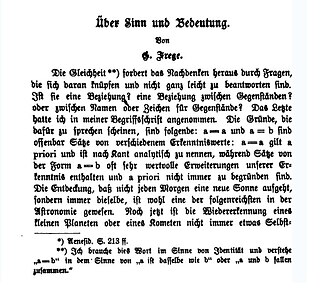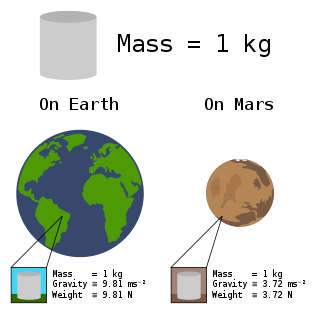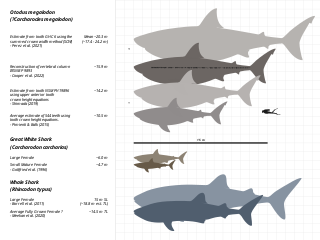In grammar, the dative case is a grammatical case used in some languages to indicate the recipient or beneficiary of an action, as in "Maria Jacobo potum dedit", Latin for "Maria gave Jacob a drink". In this example, the dative marks what would be considered the indirect object of a verb in English.

Parallax is a displacement or difference in the apparent position of an object viewed along two different lines of sight and is measured by the angle or half-angle of inclination between those two lines. Due to foreshortening, nearby objects show a larger parallax than farther objects, so parallax can be used to determine distances.
In science and engineering, the weight of an object is the force acting on the object due to gravity.
Moral relativism or ethical relativism is used to describe several philosophical positions concerned with the differences in moral judgments across different peoples and cultures. An advocate of such ideas is often referred to as a relativist for short.
In software engineering and computer science, abstraction is:

Forced perspective is a technique that employs optical illusion to make an object appear farther away, closer, larger or smaller than it actually is. It manipulates human visual perception through the use of scaled objects and the correlation between them and the vantage point of the spectator or camera. It has uses in photography, filmmaking and architecture.

Photometry, from Greek photo- ("light") and -metry ("measure"), is a technique used in astronomy that is concerned with measuring the flux or intensity of light radiated by astronomical objects. This light is measured through a telescope using a photometer, often made using electronic devices such as a CCD photometer or a photoelectric photometer that converts light into an electric current by the photoelectric effect. When calibrated against standard stars of known intensity and colour, photometers can measure the brightness or apparent magnitude of celestial objects.

In the philosophy of language, the distinction between sense and reference was an idea of the German philosopher and mathematician Gottlob Frege in 1892, reflecting the two ways he believed a singular term may have meaning.

The grammar of Standard Chinese or Mandarin shares many features with other varieties of Chinese. The language almost entirely lacks inflection; words typically have only one grammatical form. Categories such as number and verb tense are frequently not expressed by any grammatical means, but there are several particles that serve to express verbal aspect and, to some extent, mood.

The pronoun who, in English, is an interrogative pronoun and a relative pronoun, used primarily to refer to persons.
A relative clause is a clause that modifies a noun or noun phrase and uses some grammatical device to indicate that one of the arguments in the relative clause refers to the noun or noun phrase. For example, in the sentence I met a man who wasn't too sure of himself, the subordinate clause who wasn't too sure of himself is a relative clause since it modifies the noun man and uses the pronoun who to indicate that the same "man" is referred to in the subordinate clause.

In photography and cinematography, perspective distortion is a warping or transformation of an object and its surrounding area that differs significantly from what the object would look like with a normal focal length, due to the relative scale of nearby and distant features. Perspective distortion is determined by the relative distances at which the image is captured and viewed, and is due to the angle of view of the image being either wider or narrower than the angle of view at which the image is viewed, hence the apparent relative distances differing from what is expected. Related to this concept is axial magnification -- the perceived depth of objects at a given magnification.
The Topics is the name given to one of Aristotle's six works on logic collectively known as the Organon. The treatise presents the art of dialectic — the invention and discovery of arguments in which the propositions rest upon commonly held opinions or endoxa. Topoi (τόποι) are "places" from which such arguments can be discovered or invented.
Ugandan English, or Uglish, is the variety of English spoken in Uganda. The term Uglish is first recorded in 2012. Other colloquial portmanteau words are Uganglish and Ugandlish (2010).

In common usage, the mass of an object is often referred to as its weight, though these are in fact different concepts and quantities. Nevertheless, one object will always weigh more than another with less mass if both are subject to the same gravity.
Zulu grammar is the way in which meanings are encoded into wordings in the Zulu language. Zulu grammar is typical for Bantu languages, bearing all the hallmarks of this language family. These include agglutinativity, a rich array of noun classes, extensive inflection for person, tense and aspect and a subject–verb–object word order.

This article describes the syntax of clauses in the English language, chiefly in Modern English. A clause is often said to be the smallest grammatical unit that can express a complete proposition. But this semantic idea of a clause leaves out much of English clause syntax. For example, clauses can be questions, but questions are not propositions. A syntactic description of an English clause is that it is a subject and a verb. But this too fails, as a clause need not have a subject, as with the imperative, and, in many theories, an English clause may be verbless. The idea of what qualifies varies between theories and has changed over time.

In the traditional grammar of Modern English, a phrasal verb typically constitutes a single semantic unit composed of a verb followed by a particle, sometimes combined with a preposition. Alternative terms include verb-adverb combination, verb-particle construction, two-part word/verb or three-part word/verb and multi-word verb.
Otjiherero grammar is the grammar of the Herero language (Otjiherero), a Bantu language spoken primarily in Namibia. It includes several hallmarks of Bantu languages such as a large number of noun classes and the use of subject concords.

Size in general is the magnitude or dimensions of a thing. More specifically, geometrical size can refer to linear dimensions, area, or volume. Size can also be measured in terms of mass, especially when assuming a density range.








